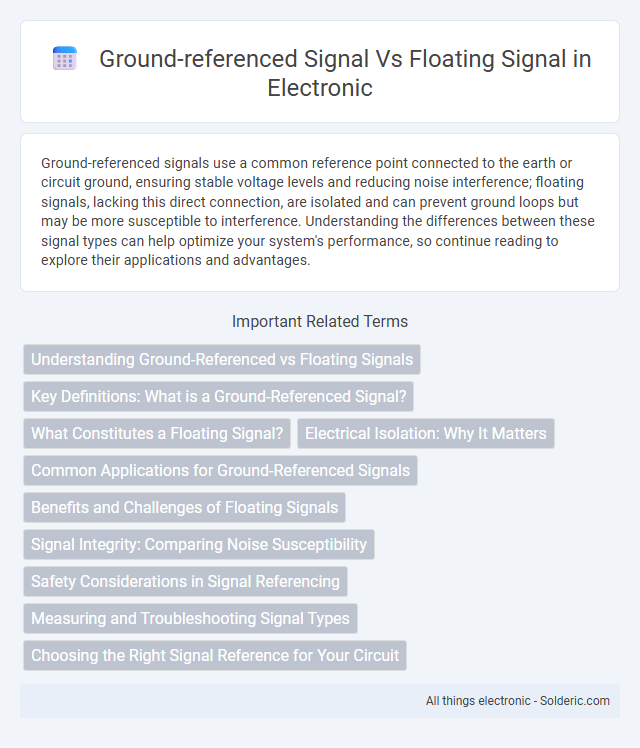Ground-referenced signals use a common reference point connected to the earth or circuit ground, ensuring stable voltage levels and reducing noise interference; floating signals, lacking this direct connection, are isolated and can prevent ground loops but may be more susceptible to interference. Understanding the differences between these signal types can help optimize your system's performance, so continue reading to explore their applications and advantages.
Comparison Table
| Aspect | Ground-Referenced Signal | Floating Signal |
|---|---|---|
| Reference Point | Connected to a common ground | Not connected to ground; isolated |
| Noise Susceptibility | Lower noise due to stable ground reference | Higher noise risk; prone to interference |
| Application | Typical in circuits with common ground | Used in isolated or differential measurement systems |
| Safety | Potential ground loop issues | Improved safety in high-voltage isolation |
| Signal Integrity | Stable and consistent waveform | Dependent on isolation and shielding quality |
| Complexity | Simple wiring and design | Requires isolation components and design effort |
Understanding Ground-Referenced vs Floating Signals
Ground-referenced signals use a common reference point, typically earth ground, ensuring signal voltages are measured relative to this stable potential, which minimizes noise and interference in circuits. Floating signals are isolated from a common ground, allowing measurement or transmission independently of ground potential, useful in avoiding ground loops and detecting voltage differences between separate systems. Proper understanding of ground-referenced versus floating signals is essential for designing reliable electrical systems and preventing faults caused by unexpected grounding conditions.
Key Definitions: What is a Ground-Referenced Signal?
A ground-referenced signal is an electrical signal whose voltage is measured relative to a common ground or zero-voltage reference point within a circuit. It ensures a stable reference by connecting one terminal to the earth or a defined ground plane, minimizing noise and interference in signal transmission. This contrasts with a floating signal, which lacks a fixed reference to ground and can lead to undefined voltage levels and increased susceptibility to noise.
What Constitutes a Floating Signal?
A floating signal occurs when the signal reference point is not connected to a fixed ground, resulting in a potential difference that can vary relative to the system ground. This lack of a defined reference can introduce noise, interference, and inconsistent voltage levels, complicating signal integrity in electronic circuits. Floating signals often arise in isolated or differential measurement systems where ground loops need to be avoided.
Electrical Isolation: Why It Matters
Electrical isolation between ground-referenced signals and floating signals prevents unwanted current paths that can cause measurement errors or equipment damage. Ground-referenced signals share a common reference point, making them susceptible to ground loops and noise interference, while floating signals operate independently of ground potential, enhancing signal integrity in noisy environments. Understanding this distinction helps you select the right signal type to maintain system accuracy and safety.
Common Applications for Ground-Referenced Signals
Ground-referenced signals are widely used in industrial automation systems for sensors, actuators, and communication interfaces due to their stable voltage reference and noise immunity. These signals are essential in applications such as motor control, PLC inputs/outputs, and measured analog signals where consistent signal integrity is critical. Ground-referenced configurations also enable simpler circuit designs and reliable fault detection in embedded systems and instrumentation.
Benefits and Challenges of Floating Signals
Floating signals provide enhanced noise immunity by isolating the signal from ground loops and common-mode interference, crucial in sensitive analog and industrial control systems. Benefits include reduced ground potential differences, which improve measurement accuracy and system reliability, especially in complex machinery or large-scale installations. Challenges involve the need for careful insulation and increased design complexity to prevent unintended coupling or interference, requiring specialized components to maintain signal integrity.
Signal Integrity: Comparing Noise Susceptibility
Ground-referenced signals typically offer superior noise immunity by providing a stable reference point that minimizes electromagnetic interference and reduces common-mode noise, enhancing overall signal integrity. Floating signals, lacking a fixed reference, are more susceptible to voltage fluctuations and noise coupling from external sources, which can degrade signal fidelity in sensitive measurement or communication systems. Careful design considerations, including shielding and differential signaling, are often required to mitigate noise susceptibility in floating signal applications.
Safety Considerations in Signal Referencing
Ground-referenced signals provide a stable voltage reference point, enhancing safety by minimizing electrical noise and reducing the risk of shock or fire hazards in your system. Floating signals, isolated from ground, can prevent ground loops and potential interference but require careful handling to avoid unintended voltage differentials that could compromise equipment or operator safety. Proper selection and maintenance of signal referencing ensure reliable operation while prioritizing safety in complex electrical environments.
Measuring and Troubleshooting Signal Types
Ground-referenced signals provide a stable reference point, minimizing noise and interference during measurement, making troubleshooting more straightforward in electrical systems. Floating signals lack a common ground reference, which can lead to ambiguous readings and complicate fault diagnosis, particularly in complex circuits or isolation scenarios. Using appropriate measurement tools, such as differential probes or isolation amplifiers, is essential to accurately troubleshoot floating signals and prevent erroneous data interpretation.
Choosing the Right Signal Reference for Your Circuit
Choosing the right signal reference for your circuit depends on factors like noise immunity and measurement accuracy. Ground-referenced signals are ideal for systems with a common ground, reducing interference and simplifying circuit design, while floating signals provide isolation, preventing ground loops in complex or sensitive setups. Understanding your circuit's grounding scheme ensures optimal signal integrity and reliable operation.
ground-referenced signal vs floating signal Infographic

 solderic.com
solderic.com